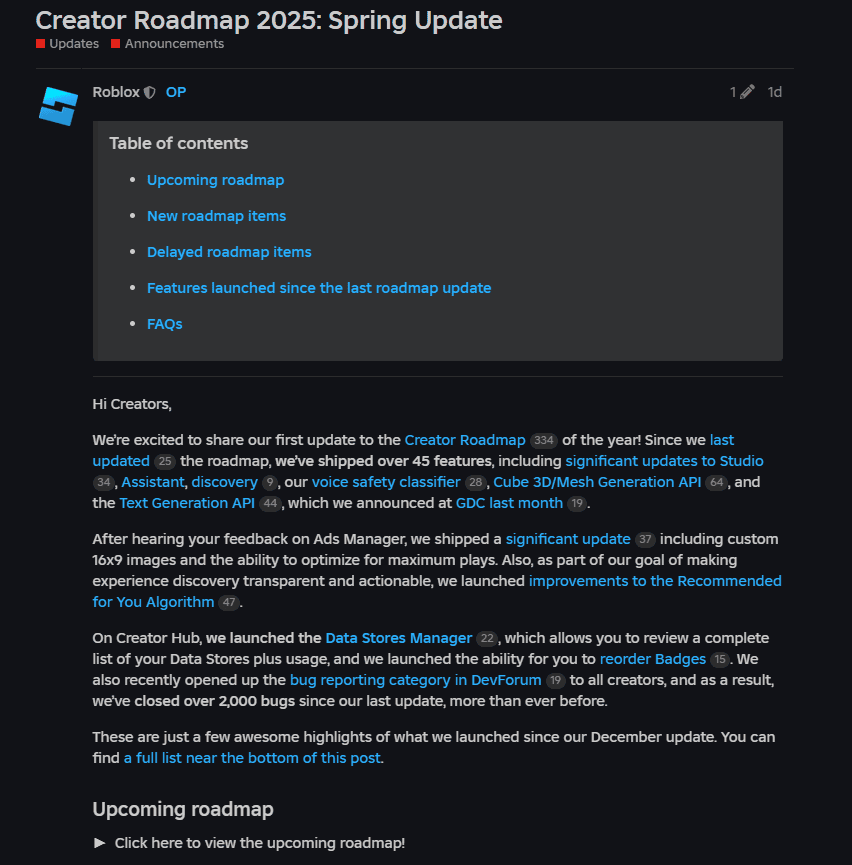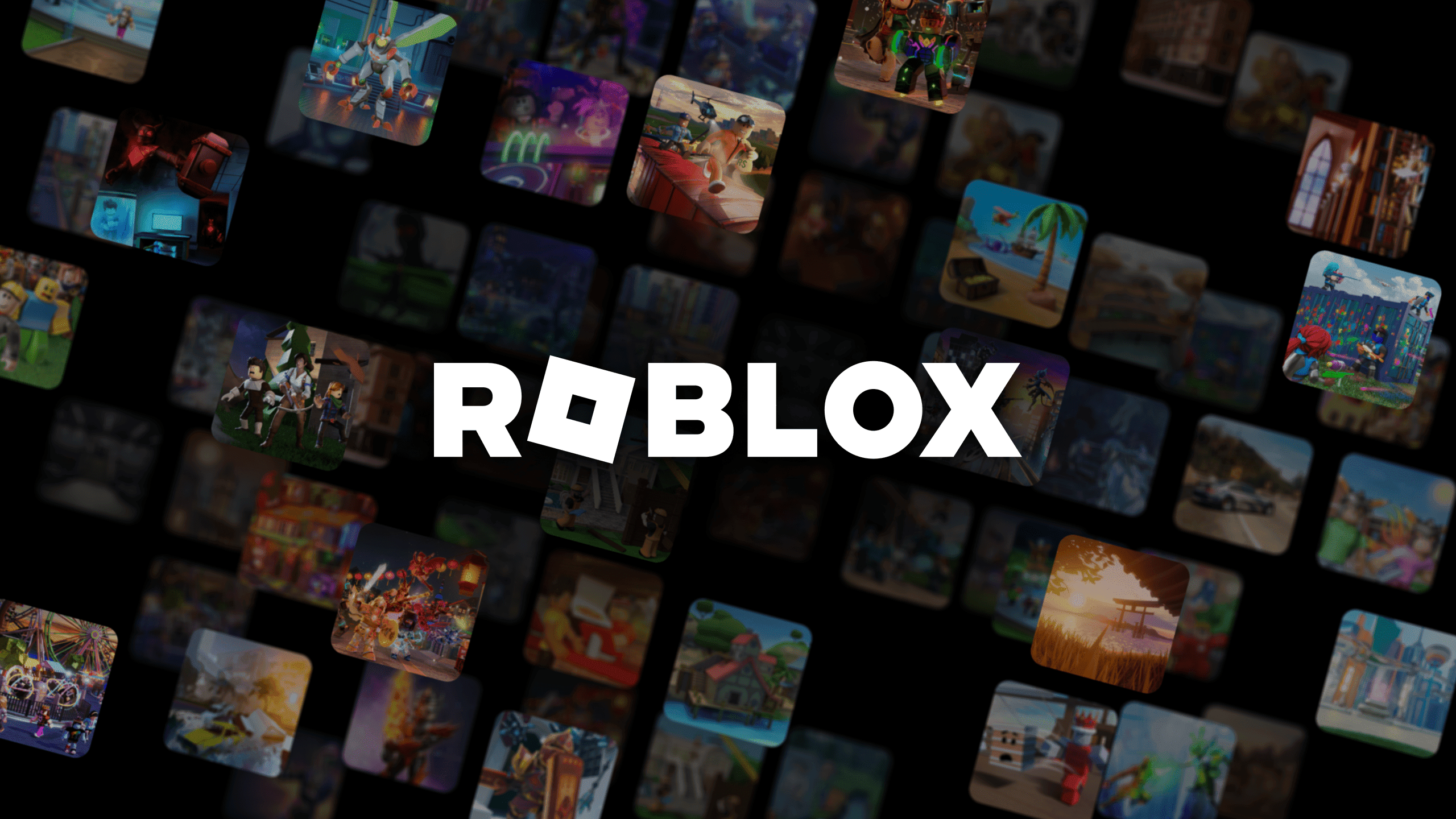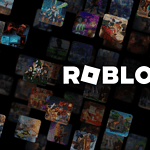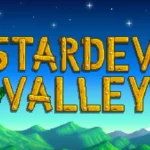Roblox’s evolution has always been tightly linked to the passion and creativity of its global creator community. In a platform where over 15 million creators are actively building and monetizing experiences, every major update can ripple across the ecosystem. The Spring 2025 Update is one of the most impactful in years—bringing sweeping enhancements to Roblox Studio, the Creator Hub, APIs, and underlying systems. This isn’t just a “quality of life” patch; it’s a reimagining of how developers build, manage, and scale their worlds.
Let’s dive into everything you need to know—and why these updates matter more than ever.

https://devforum.roblox.com/t/creator-roadmap-2025-spring-update/3624895
New Tools That Will Transform Development Workflows
Upgraded Navigation and Studio Performance
- Creator Hub Overhaul (mid-2025): Finding documentation, asset libraries, and updates is about to get a lot easier with a streamlined navigation system. This change lays the groundwork for a future where managing massive projects (think AAA-style Roblox games like Frontlines or Deepwoken) feels much less chaotic.
- Find All/Replace All Optimization: Refactoring large codebases, once a frustrating slowdown, is getting a speed boost. Roblox’s backend enhancements will help developers operating at scale (like those building live-service games) work faster and more reliably.
- Studio Luau File Sync Release: For those using professional IDEs like VSCode or Visual Studio, the support for Language Server Protocol (LSP) through Luau sync is a massive leap. This blurs the line between indie developers and professional studio-quality coding on Roblox.
- Lighting Expansion: With the light range increasing to 120 studs, expect more cinematic experiences with true volumetric lighting—something many serious developers had been requesting for more atmospheric games.
- Data Stores Manager Beta: This long-requested feature will give developers real-time insights into how their games are handling data. Think of it like built-in analytics for inventory systems, player saves, and progression models.
Unlocking Next-Level Experiences: New APIs That Matter
Pushing Procedural Generation and AI
- Cube 3D/Mesh Generation API: This opens the door to fully procedural worlds—imagine a No Man’s Sky on Roblox, where players explore endless, dynamically generated planets.
- Text Generation API (Beta): By tapping into natural language AI, creators can generate dynamic dialogue, mission descriptions, or even live event narratives. Early adopters are already experimenting with in-game AI storytelling bots.
- Real-Time Translation API: Targeting Roblox’s goal of reaching a truly global audience (it already has over 70 million daily users worldwide), this tool will help even small studios offer multi-language support instantly.
- Accessory Adjustment APIs: Beyond fashion, this gives players deep personalization tools. As user avatars become a crucial part of identity and UGC (user-generated content) sales, this feature could fuel a new wave of microtransactions.
- Haptic Feedback APIs (Studio Beta): With gaming peripherals like haptic vests and gloves entering mainstream gaming, Roblox’s support for tactile feedback positions it ahead of most major gaming platforms in immersive experience design.
Critical Platform Changes: Goodbye Legacy, Hello Efficiency
Fundamental Shifts You Can’t Ignore
- Retirement of Legacy Chat (April 30, 2025): All games must move to TextChatService, which not only enhances moderation but opens up more rich text features. This transition echoes a broader gaming industry trend where trust and safety have become non-negotiable for platforms serving minors.
- Regional Pricing for Game Passes: In response to the platform’s explosive growth in regions like Southeast Asia and Latin America, developers can now set localized prices, increasing purchase accessibility—and potentially their bottom lines.
- Game Server Performance Dashboards: Monitoring CPU, memory, and latency server-side is now a native feature. Studios building experiences at the scale of Adopt Me! or Brookhaven can now track their optimization metrics in real-time.
- Memory Stores Extended Services: For ultra-large games handling millions of active players, developers can now buy additional MemoryStore capacity—a nod to Roblox’s expanding ambition to rival traditional gaming backends like AWS Gamelift or Azure PlayFab.
Content Creation, Monetization, and Moderation Improvements
Smoother Operations and New Revenue Opportunities
- Sell Models on Creator Store (mid-2025): Creators will soon be able to directly sell 3D models. Considering UGC avatar items already generated over $500 million for creators in 2024 alone, this expansion could make asset creation another lucrative vertical.
- Community Keyword Blocklists: Owners of large experiences or communities will have stronger tools to filter harmful content without waiting on Roblox moderation, a move that’s been widely requested by developers managing millions of daily interactions.
- Clearer Moderation Messages with Previews: Better transparency in moderation could help creators recover and rework flagged content faster, smoothing the experience for small indie creators who often get caught in vague moderation cycles.
Learning, Discovery, and Accessibility: A Platform Growing Up
- Docs Available Directly in Studio: New developers no longer need to open 10 browser tabs to find Lua documentation—Studio itself will guide them with inline references.
- Official Tutorials In-Studio (early 2025): Roblox wants to dramatically lower the learning curve. In-platform tutorials covering everything from scripting basics to UI design will make professional development skills far more accessible.
- DevForum Auto-Translation: Building a truly global dev community means shattering language barriers—and this is a step toward making a U.S.-centric platform truly international.
- Cross-product Creator Home (mid-2025): Expect an integrated hub across Creator Hub, Studio, and Asset Store—mirroring the kind of unified ecosystems professional software like Unreal Engine and Unity have long offered.
Roblox’s Spring 2025 Update Isn’t Just Big—It’s Evolutionary
This update is setting the stage for the next phase of Roblox’s future: a platform where anyone, from a solo developer in Manila to a 100-person studio in Los Angeles, can build sophisticated, scalable, and professional-grade experiences.
From improved workflows and monetization to AI-driven creativity and global accessibility, Spring 2025 is Roblox’s boldest play yet to dominate the future of user-generated gaming.
Roblox vs. Infinite Craft
Infinite Craft is a browser-based crafting game that has gained popularity for its simple yet addictive gameplay. Players combine elements to create new items in an ever-expanding universe of possibilities, similar to but distinct from other creation platforms.
Comparison with Roblox
While both Infinite Craft and Roblox are creativity-focused platforms, they function quite differently. Roblox is a massive multiplayer online platform where users create and share games using Roblox Studio. It features complex 3D environments and coding capabilities.
Infinite Craft, on the other hand, is much simpler. It focuses purely on combining elements to discover new creations. The game doesn’t require programming knowledge or advanced technical skills.
The social aspects also differ significantly. Roblox has a robust community with millions of active users who interact in real-time. Infinite Craft lacks this multiplayer component, making it a more solitary experience.
Users often enjoy both platforms for different reasons – Roblox for its immersive social gaming experiences, and Infinite Craft for its relaxing, puzzle-like discovery system.
The Rise of Infinite Games
The concept of “infinite” games has gained significant traction in the PC gaming market. These titles emphasize unlimited creativity and endless gameplay rather than structured narratives or defined endpoints.
Infinite Craft exemplifies this trend perfectly. The game features no set objectives or completion points – players simply continue discovering new combinations indefinitely. This open-ended design appeals to those seeking relaxing, low-pressure gaming experiences.
Other examples in this category include Minecraft’s creative mode and No Man’s Sky. These games share a common focus on exploration and creation without artificial limitations.
The rising popularity of these titles reflects changing player preferences. Many gamers now seek experiences that respect their time and creativity rather than forcing them through predetermined paths.
Social media has further fueled this trend, with players sharing their unique discoveries and creations across platforms like YouTube and Reddit.






